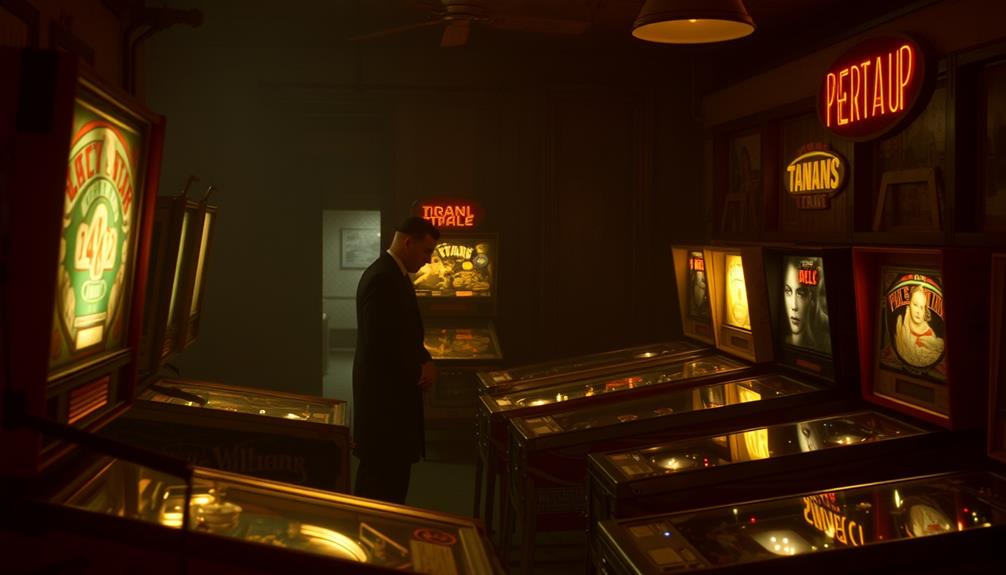Pinball machines have a tilt mechanism in place to ensure fair gameplay and uphold integrity. If you happen to nudge the machine too vigorously, a tilt pendulum will detect the movement and issue warnings. Continued excessive nudging can result in decreased flipper power, making it more challenging to play effectively. The tilt mechanism serves as a tool to teach players how to better control the ball without facing penalties. It promotes the use of skillful nudging techniques that can elevate overall gameplay. By mastering these strategies, not only can you avoid losing the game but also increase your scoring potential. Interested in learning how to effectively use nudging techniques? There’s more to discover about it!
Key Takeaways
- Pinball machines tilt to prevent excessive nudging, maintaining fair play and game integrity.
- The tilt mechanism uses a pendulum to detect movement, triggering warnings before penalties.
- Up to three warnings are permitted; excessive nudging leads to loss of flipper power and bonuses.
- Tilt sensitivity can be adjusted to cater to different player skill levels and preferences.
- Mastering nudging techniques enhances gameplay strategy while respecting the machine's tilt rules.
Understanding the Tilt Mechanism
When you play a pinball machine, understanding the tilt mechanism is vital for mastering the game. This mechanism prevents excessive nudging, which can unfairly alter the ball's trajectory and guarantees a level playing field for all players.
Notably, similar principles of control and balance can be seen in astrology and attractiveness, where understanding one's traits can enhance social interactions. A tilt pendulum under the playfield swings within a loop to detect movement. When your nudging exceeds acceptable limits, it triggers tilt warnings, alerting you to adjust your technique.
Typically, you get up to three warnings before the game tilts, at which point your flipper power is disabled, and any accumulated bonuses are forfeited. This makes it vital to find the right balance between acceptable nudging and excessive movement. Frequent tilting indicates a lack of control, which can seriously hinder your performance.
Notably, the tilt mechanism's sensitivity can also be adjusted through the tilt bob's weight, allowing machine owners to customize how easily the tilt triggers. By understanding the nuances of this mechanism, you can fine-tune your gameplay and avoid unnecessary penalties.
Mastering the tilt warnings will ultimately elevate your pinball skills and enhance your overall experience.
Importance of Tilt in Gameplay

Understanding the importance of tilt in gameplay can greatly enhance your pinball experience. The tilt mechanism acts as an anti-cheat measure, ensuring fair competition by limiting excessive nudging. When you push too hard, you'll receive a tilt warning, and after a few warnings, the machine will disable flipper power, causing a ball drain.
To master your gameplay, it's essential to manage your nudges effectively. Skilled players know how to use controlled nudges to avoid penalties, enhancing their strategies. You can also adjust tilt settings to match your playing style, balancing risk and control during critical moments.
Here's a quick overview of tilt's impact on your gameplay:
| Aspect | Description |
|---|---|
| Tilt Mechanism | Prevents cheating through excessive nudging |
| Tilt Warnings | Receive warnings before a game tilt occurs |
| Gameplay Strategy | Controlled nudges improve overall strategy |
| Tilt Settings | Adjust sensitivity for personalized experience |
Recognizing these elements will not only improve your gameplay but also deepen your appreciation for the game's design and integrity. Enjoy the challenge and make every nudge count!
Types of Nudging Techniques

When you play pinball, nudging techniques can make a big difference in your game. Employing these techniques can enhance your ability to control the ball and navigate challenging layouts, similar to how sprayers reduce fatigue during extensive painting tasks.
You can use gentle nudges to subtly guide the ball without triggering tilt warnings, or you might explore advanced strategies for more control. Understanding these techniques helps you adapt your gameplay to different machines and maximize your score.
Gentle Nudge Techniques
Mastering gentle nudge techniques can be a game-changer for any pinball enthusiast. These subtle movements of the pinball machine allow you to influence the ball's trajectory without triggering tilt warnings, which is essential for maintaining control during gameplay.
To execute effective player nudges, gently push the machine in the direction you want the ball to go. It's vital to do this in a way that minimizes the risk of exceeding tilt sensitivity. Understanding high-quality content can enhance your gameplay experience, as it provides valuable insights into various strategies.
Timing plays a significant role in your nudging success. Many skilled players rely on a rhythm, performing nudges in intervals that sync with the ball's movement. This method helps avoid triggering tilt warnings, allowing you to play more strategically.
Some pinball tables, such as those from Zen Originals, even permit a specific number of nudges during recovery periods, which gives you a valuable opportunity to use this technique effectively.
Advanced Nudging Strategies
How can you elevate your pinball game through advanced nudging strategies? Mastering these techniques can give you an edge, enhancing your control over the ball while minimizing the risk of triggering tilt bobs. Here's a breakdown of key nudging techniques you can utilize:
| Technique | Description |
|---|---|
| Soft Nudging | Gently moving the machine to influence the ball's trajectory without tilting. |
| Deadening Nudges | Dampening the ball's momentum just before critical gaps to guarantee smoother movement. |
| Timing Nudges | Nudging in sync with the ball's movement during critical moments, managing tilt warnings effectively. |
Utilizing edge nudges can also help alter the ball's angle just before it hits a flipper gap, preventing drains. Multi-directional nudging combines movements in various directions, allowing you to adjust the ball's path dynamically. However, be cautious; combining these techniques requires precision to avoid triggering tilt penalties. With practice and careful execution, you can integrate these advanced nudging strategies into your gameplay, making your pinball experience both thrilling and rewarding.
Effects of Excessive Nudging

Excessive nudging can quickly turn a fun pinball session into a frustrating experience. When you push the boundaries of nudging, you activate the tilt mechanism, which can lead to warnings and, ultimately, the disabling of your flipper power. Most machines will issue two tilt warnings before they penalize you with a game tilt.
The tilt bob, a pendulum mechanism, detects movement through a rod and circuit loop. If you nudge too aggressively, the pendulum swings, triggering those warnings. Understanding the nuances of game mechanics is essential, as a well-managed approach can enhance your overall enjoyment and performance in the game. Additionally, practicing good financial habits, like creating a budget, can help you allocate your time and resources wisely, leading to a more fulfilling gaming experience creating a personal budget.
As you play, it's essential to balance your nudging technique. Frequent tilting doesn't just risk penalties; it can also forfeit your accumulated bonuses and lead to a ball drain, which negatively impacts your overall gameplay.
Different machines have varying calibrations for tilt sensitivity, but excessive nudging generally results in penalties that disrupt your game flow and strategy.
To truly enjoy your pinball experience, be mindful of how much you nudge. Finding that sweet spot between a gentle nudge and excessive nudging will help you maintain control and keep the fun alive, reducing the chances of a frustrating tilt.
History of Tilt Mechanisms

You might be surprised to learn how tilt mechanisms have evolved over the years to maintain game integrity.
Originally, a simple pendulum system warned players when they nudged too hard, but today's technology uses advanced sensors to distinguish between legitimate nudging and excessive force.
This evolution not only enhances gameplay but also guarantees fairness, making tilt mechanisms a critical feature in modern pinball machines.
Additionally, energy-saving features found in modern systems parallel the improvements in tilt technology, as both aim to optimize performance and user experience.
Evolution of Tilt Mechanisms
Tilt mechanisms in pinball machines have come a long way since their inception, evolving from rudimentary physical restraints to sophisticated electronic systems. Early machines relied on simple mechanical components, which didn't provide much in the way of precise tilt detection. These early systems were prone to being activated by even minor nudges or vibrations, leading to frustration for players. However, modern pinball machines now use advanced electronic tilt mechanisms that can accurately detect the exact amount of force and direction applied to the machine. This helps prevent accidental tilting and allows for more fair gameplay. Additionally, these electronic systems can also provide feedback to players, explaining what happens when you tilt and why it is important to avoid excessive nudging. Understanding the tilt in pinball is crucial for players to strategize and play more skillfully. By knowing the consequences of excessive nudging or tilting, players can develop a better sense of control and precision in their gameplay. This not only enhances the overall experience for the player but also adds a level of strategy and skill to the game. Overall, the evolution of tilt mechanisms in pinball machines has greatly improved the fairness and enjoyment of the game for players of all skill levels.
As technology advanced, the introduction of tilt pendulum systems allowed for more accurate monitoring of player nudging, enhancing gameplay integrity. This evolution mirrors the importance of nurturing an imaginative mindset in design thinking, emphasizing how innovation drives engagement and user experience.
Now, modern tilt mechanisms utilize electronic tilt detection with accelerometers, improving sensitivity and precision. This evolution hasn't only made the game more enjoyable but also fairer.
Here are some key advancements in tilt mechanisms:
- Shift from mechanical to electronic systems
- Enhanced sensitivity with accelerometers
- Adjustable sensitivity settings for players
These advancements allow you to customize the tilt thresholds, catering to your unique skill level and play style.
The historical significance of these mechanisms highlights their essential role in maintaining fair play, preventing excessive manipulation of the machine. With each evolution, the experience of playing pinball continues to be refined, ensuring that your gameplay remains challenging yet rewarding.
Impact on Game Integrity
Pinball machines have long relied on tilt mechanisms to uphold the integrity of gameplay, ensuring that players engage with the machine fairly. Initially, these machines lacked sophisticated tilt systems, leading to issues with excessive nudging and cheating. To combat this, the tilt pendulum mechanism was developed, swinging within a loop to detect movement and issue warnings. This system set the stage for maintaining game integrity, as it penalized players who overstepped the boundaries of fair play.
Just as essential oils like peppermint oil can enhance respiratory function, the tilt mechanism enhances the gaming experience by maintaining the challenge and fairness of play.
As technology advanced, modern tilt systems emerged, incorporating advanced detection technology that refined how tilt mechanisms function. These improvements not only enhanced the player experience but also preserved the challenge and strategy that pinball is known for. The tilt mechanism now balances player interaction with the machine while minimizing the risk of exploiting its mechanics.
Ultimately, the evolution of tilt mechanisms reflects an ongoing commitment to game integrity. By preventing excessive nudging and ensuring fair play, these systems play a vital role in keeping the spirit of pinball alive. You can appreciate the artistry of gameplay, knowing that the tilt mechanism stands guard against unfair advantages, enhancing your overall experience.
Community Perspectives on Tilting

Within the vibrant pinball community, perspectives on tilting vary widely, reflecting a deep-seated passion for the game. The tilt mechanism in pinball machines is designed as an anti-cheat feature, but it also sparks heated debates among players. Some see tilting as a necessary tactic that enhances gameplay, while others believe it disrespects the machine's integrity.
This ongoing discourse resonates with themes of authenticity and existence, as players navigate the balance between personal enjoyment and respect for the game's rules.
Community opinions on tilting often highlight the following points:
- Respect for the Machine: Many players advocate for no tilting, especially in competitive settings, as they emphasize the importance of maintaining the game's integrity.
- Skill vs. Luck: Frequent tilting tends to be associated with lower skill levels, indicating a reliance on risky maneuvers rather than strategic gameplay.
- Mastering Nudging: Skilled players often differentiate themselves by mastering nudging techniques without triggering the tilt mechanism, showcasing their control and finesse.
Ultimately, these diverse perspectives enrich the pinball experience, fostering discussions that celebrate both the challenges and the artistry of the game.
Whether you believe in tilting or not, it's clear that opinions will continue to shape the community's approach to pinball.
Strategies for Effective Nudging

Mastering the art of nudging can be a game-changer for players looking to enhance their pinball experience. Effective nudging involves precise, gentle movements to influence the ball's trajectory without triggering tilt warnings. To succeed, familiarize yourself with the tilt warning system of your machine and understand how many nudges are allowed and the timing required between them.
Here's a quick reference table for common nudging strategies:
| Strategy | Description |
|---|---|
| Gentle Nudges | Use soft nudges to guide the ball |
| Timing | Space nudges every few seconds |
| Machine Knowledge | Understand specific tilt warnings |
| Gap Navigation | Move the ball away from danger |
Utilizing nudges strategically can help you maneuver the ball away from dangerous gaps, allowing you to maintain control and prolong your game. For instance, Williams tables permit one free nudge every 5 seconds, so plan your actions carefully. By mastering these nudging techniques, you'll improve your gameplay and boost your scores, especially in competitive settings. Remember, it's all about staying within the limits to avoid tilt warnings!
Tilt Settings and Adjustments

Understanding tilt settings and adjustments can greatly enhance your pinball experience, especially after honing your nudging techniques. The tilt mechanism relies on a pendulum that detects movement, and if you nudge too much, you'll receive tilt warnings. Typically, three warnings will result in a game tilt.
This aspect of gameplay can be particularly fascinating as it reveals the intricate balance between skill and control, much like how curiosity fosters social connections and relationships in various aspects of life.
You can modify tilt settings through the game's service menu, allowing you to customize sensitivity based on your skill level. This is vital for advanced players who want more nuanced control without triggering tilts.
Here are some key adjustments you might consider:
- Number of warnings: Set how many warnings you want before a tilt occurs.
- Tilt sensitivity: Adjust how sensitive the machine is to nudging.
- Penalties for tilting: Determine what happens when you tilt—loss of ball, score penalties, etc.
Proper calibration of tilt settings is essential. If the tilt is too tight, it can lead to frustration during competitive play.
Consequences of Game Tilt

When you experience a game tilt, you face immediate penalties, like losing flipper power and any bonuses you've built up. This not only disrupts your current game but also forces you to rethink your strategy as you navigate the risk of tilting.
For instance, just like in family photoshoot fails, where unexpected events can lead to humorous outcomes, a tilt can change the trajectory of your game in an instant.
Balancing your nudging techniques becomes essential if you want to maintain control and improve your overall performance.
Game Penalties Explained
Experiencing a game tilt can be a frustrating moment in pinball, as it brings several penalties that impact your score and strategy. When you trigger a tilt warning, you usually get up to three warnings before the game fully tilts. If that happens, you'll lose flipper power, and the ball will automatically drain.
This means you not only lose your current ball but also forfeit any accumulated bonuses, which can considerably hurt your overall score.
Here are some key penalties to keep in mind:
- Loss of flipper power: You can't control the game effectively, making it harder to save the ball.
- Automatic ball drain: Once the tilt is activated, you lose your current ball without any chance of saving it.
- Forfeited bonuses: All the points you've worked hard to accumulate vanish, impacting your progress.
The tilt mechanism serves as an anti-cheat measure, ensuring fair play.
Impact on Strategy
The consequences of a game tilt can markedly alter how you approach your strategy in pinball. When you trigger a tilt, flipper power is disabled, leading to an immediate ball loss that can severely impact your score. To avoid this, you'll need to balance your nudging techniques carefully. Excessive nudging can trigger tilt warnings, disrupting your gameplay momentum.
Adapting your strategy becomes essential. Each machine has different tilt settings, so you must adjust your gameplay based on the sensitivity of that specific tilt mechanism. This requires honing your nudging skills to influence the ball flow without risking a tilt.
Consider how you'll weigh the risks:
| Action | Consequence |
|---|---|
| Excessive nudging | Triggers tilt warning |
| Precise nudging | Maintains ball control |
| Ignoring tilt settings | Risk of immediate loss |
| Adapting strategy | Increases scoring potential |
| Risk management | Balances gameplay flow |
Understanding these consequences encourages you to incorporate risk management into your strategy, allowing you to enjoy the game while minimizing the chance of tilting and losing your hard-earned progress.
Ethical Considerations in Pinball

Although it might seem tempting to nudge a pinball machine to gain an advantage, ethical considerations play an essential role in maintaining the integrity of the game. The tilt mechanism is designed as an anti-cheat measure to prevent excessive nudging, which can unfairly manipulate gameplay and scores.
When you respect the machine and its rules, you contribute to a fair playing environment for everyone.
Here are some important ethical points to reflect upon:
- Respect for the Game: Excessive nudging can damage the machine and disrupt the enjoyment for other players.
- Skill Development: Mastering the art of nudging without tilting shows a level of control and respect, distinguishing skilled players from those who rely on manipulation.
- Context Matters: Debates arise about the acceptability of tilting in home versus competitive settings, with many arguing that it's disrespectful in competitions.
Ultimately, ethical gameplay involves honing your skills rather than exploiting the tilt mechanism.
Frequently Asked Questions
What Is the Point of the Tilt in Pinball?
The point of the tilt in pinball is to promote fair play. It discourages excessive nudging, encouraging you to master your technique while maintaining game integrity. Balancing your nudges helps maximize your score without penalties.
Is Tilting Illegal in Pinball?
No, tilting isn't illegal in pinball; it's a built-in mechanic. You can nudge the machine, but excessive movement triggers penalties. In competitive play, strict rules enforce fair play, so be mindful of your nudging!
What Does It Mean When a Machine Says Tilt?
When your machine mentions "tilt," it signals trouble. You've nudged too much! This warning warns you, leading to penalties that can ruin your game. Control your movements to keep the fun flowing smoothly.
Where Did the Pinball Tilt Come From?
The pinball tilt mechanism originated as an anti-cheat feature. It prevents you from nudging the machine too much, ensuring fair play while allowing some player control, reflecting advancements in technology over time.
Conclusion
In the world of pinball, think of the tilt mechanism as the game's way of keeping you honest, like a referee in a close match. If you push too hard, you lose the thrill of the game. Just like life, where a gentle nudge can steer you in the right direction, mastering the art of nudging in pinball keeps the excitement alive. So next time you're playing, remember to balance your moves—after all, it's all about enjoying the ride!









